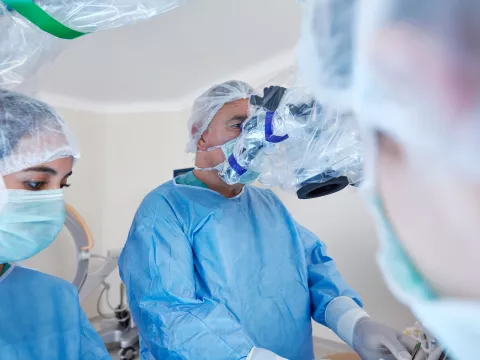- AdventHealth

Choose the health content that’s right for you, and get it delivered right in your inbox.
Prostate cancer is the most common non-skin malignancy in men and the second-most common cause of cancer-related deaths in the U.S. after lung cancer. The American Cancer Society estimates that about 268,490 new patients will be diagnosed with prostate cancer by the end of 2022. About one in eight men will be diagnosed with prostate cancer during their lifetime, but only about one in 41 will die of the disease.
Fortunately, prostate cancer tends to be slow-growing compared to other types of cancer. When prostate cancer is detected and treated early, it tends to be low-grade and slow-growing with excellent survival rates
Understanding Prostate Cancer
The prostate is a small gland (approximately the size of a walnut) located just below the bladder and above the rectum. It produces prostatic fluid that mixes with fluid from the seminal vesicles and the sperm produced by the testicles to form semen. The prostatic fluid carries a protein called prostate-specific antigen (PSA) that prevents the semen from clotting. The gland is surrounded by a sheath of muscle and a fibrous capsule.
Within the body, cells normally grow in an orderly fashion; however, sometimes cells go through changes that result in a cancerous tumor. Prostate cancer is a disease in which cancer cells form in the tissues of the prostate. The most common type of prostate cancer is called adenocarcinoma of the prostate, as the cancerous cells proliferate from the prostatic glands.
What Causes Prostate Cancer?
While researchers are still figuring out what exactly causes prostate cancer, there are a few risk factors that play into why prostate cells become cancer cells in some men. Cancer can be caused by DNA mutations or other changes that keep cancer genes turned on, or that turn off tumor suppressor genes. These types of gene changes can lead to cancer cells growing out of control.
DNA changes can either be inherited from a parent or they can be acquired during a person’s lifetime. Inherited gene changes are thought to play a role in about 10% of prostate cancers. Acquired gene mutations are only found in cells that come from the original mutated cell. These are not passed on to children.
How is Prostate Cancer Diagnosed?
According to the Centers for Disease Control and Prevention (CDC), a biopsy is the main tool for diagnosing prostate cancer, but a doctor can use other tools to help make sure the biopsy is targeted to the right place. For example, doctors may use transrectal ultrasound or magnetic resonance imaging (MRI) to help guide the biopsy.
With transrectal ultrasound, a probe the size of a finger is inserted into the rectum and high-energy sound waves (ultrasound) are bounced off the prostate to create a picture of the prostate called a sonogram. MRI uses magnets and radio waves to produce images on a computer. MRI does not use any radiation.
Prostate Cancer Staging
If prostate cancer is diagnosed, other tests are done to find out if cancer cells have spread within the prostate or to other parts of the body. This process is called staging. Whether the cancer is only in the prostate, or has spread outside the prostate, determines your stage (or extent) of prostate cancer. The stage of prostate cancer tells doctors what kind of treatment you need.
Is Prostate Surgery Considered a Major Surgery?
Prostate removal surgery is called a prostatectomy, and it is a major surgery. It may take at least several weeks before you feel like yourself again.
Patients usually stay overnight in the hospital for observation. Over-the-counter medicines like Tylenol and Ibuprofen are recommended for pain relief, and if those aren’t sufficient, your doctor may prescribe pain killers. Most patients return to work within two weeks, but you won’t be able to lift heavy objects for four weeks. You should be able to return to all your normal activities within six weeks, depending on your progress.
What types of Surgery are used to treat prostate cancer?
Modern advancements in technology allow for smaller incisions (about the size of a dime) to be used by the surgeon rather than through a larger single incision (open prostatectomy). Open prostatectomy is the traditional method used mostly in the past. This modern minimally invasive approach is called a laparoscopic prostatectomy.
In laparoscopic surgery, the surgeon uses special long surgical tools (instruments) to remove the prostate. The surgeon either holds these instruments directly (traditional laparoscopic prostatectomy), or uses a surgeon-controlled console system to precisely move the robotic arms that hold the instruments (robotic laparoscopic prostatectomy). The current system being used for robotic laparoscopic prostatectomy is the da Vinci robot™.
Benefits of Robotic Surgery
Compared to traditional open surgery:
- Incisions are smaller, providing a quicker return to normal daily activities
- Increased magnification of the surgery site to 10-times the size, combined with easily maneuverable robotic arms and instruments, which provides superior control and improved functional outcomes
- Less risk of blood loss
- Shorter hospital stay; most patients leave within 24 hours
- Quicker return to work
World-Class Robotic Surgery Team
To learn more about our world-class team and how we can care for you in body, mind and spirit, visit us here.





